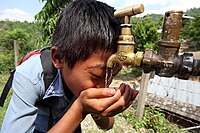
Photo from wikipedia
In semiarid regions, salinization and anthropogenic contaminants are considered as the principal threat to groundwater resource availability. Consequently, the origin and processes of salinization should be identified, to take a… Click to show full abstract
In semiarid regions, salinization and anthropogenic contaminants are considered as the principal threat to groundwater resource availability. Consequently, the origin and processes of salinization should be identified, to take a sustainable measurement to mitigate these problems. In the present study, groundwater samples from 18 dug wells were collected during the sampling campaign carried out in May 2016 in order to identify the main natural and anthropogenic processes that control the quality of groundwater in the Mornag shallow aquifer (northeastern Tunisia) and to evaluate its suitability for agricultural irrigation purpose. This may create a clear database for decision maker to take suitable actions to sustainably manage the groundwater resources. The hydrogeochemical parameters (major ions concentration, pH, TDS, EC) were examined to assess the quality of groundwater and to identify the main mineralization processes. Permeability index (PI), percentage of sodium (%Na) and the ratio of sodium adsorption (SAR) were investigated to evaluate the groundwater suitability for irrigation. It has been demonstrated that the major ions abundance follows the order of sodium > calcium > magnesium > potassium and chloride > sulfate > bicarbonate > nitrate. Dissolution of evaporite minerals, such as halite, gypsum and anhydrite, and reverse ion exchange are the predominant processes of groundwater mineralization, generating the Cl–SO 4 –Ca and Na–Cl major water types. The calculated irrigation water quality index displayed that 55% of the Mornag groundwater samples are distinguished by elevated SAR and PI, suggesting their unsuitability for irrigation. So, the present study has provided a precious insight into the major geochemical processes occurring in the Mornag shallow groundwater and their suitability for irrigation which will support future management of these resources.
Journal Title: Environment, Development and Sustainability
Year Published: 2020
Link to full text (if available)
Share on Social Media: Sign Up to like & get
recommendations!